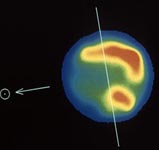Rare molecule in Venus could affect greenhouse mechanism on planet

Paris, Oct 11 : Astronomers have tracked down a rare molecule in the atmosphere of Venus that could affect the way the greenhouse mechanism works on the gaseous planet.
A team of astronomers from France, Belgium and Russia used the Infrared Atmospheric Spectrometer (SOIR) instrument to measure solar occultations on Venus.
This instrument watches the Sun set behind Venus, allowing the scientists to study the way specific wavelengths of light are absorbed by the planet's atmosphere.
These wavelengths and the level of absorption then give away the identity and amount of gases in the atmosphere.
The researchers led by Jean-Loup Bertaux, Service d'Aeronomie du CNRS, France and Ann-Carine Vandaele, Institut d'Aeronomie Spatiale de Belgique, saw an unidentified signature at 3.3 micrometres in the mid-infrared region of the spectrum.
“It was conspicuous and systematic, increasing with depth in the atmosphere during the occultation, so we knew it was real,” said Bertaux.
The team kept their discovery confidential as they attempted to identify the molecule responsible. They thought at first that it must be an organic molecule.
These molecules contain carbon and hydrogen. However, none of the known organic molecules fitted well with the observations.
Then, in December 2006, Mike Mumma of NASA's Goddard Space Flight Center, Maryland, enquired whether the SOIR team was seeing anything special on Venus at 3.3 microns. He said he had discovered an unidentified spectral signature at that wavelength using telescopes on Hawaii pointing at Mars. The two teams compared the absorption signatures and found they were identical.
The scientists said this was a big clue.
Both the atmospheres of Mars and Venus are composed of 95 percent carbon dioxide, although Venus's atmosphere is much thicker than the one at Mars.
The NASA team suggested that the signature could be coming from an isotope of carbon dioxide, where one oxygen atom is 'normal', with eight protons and eight neutrons, while the other has eight protons and ten neutrons.
Such an isotope makes up about one percent of carbon dioxide on Earth; the rest contains two normal oxygen atoms.
As no one had previously seen the molecule absorb at 3.3 micrometres, the scientists decided to carry independently investigate the phenomenon.
Three groups led by Mumma in America, Sergei Tashkun and Valery Perevalov at Tomsk State University, Russia, and Richard Dahoo at Service d'Aeronomie du CNRS all came to the same conclusion that the signature could be caused by a rare transition only possible in the isotope.
The study, 'First Observation of 628 CO2 isotopologue band at 3.3 micrometres in the atmosphere of Venus by solar occultation from Venus Express' was announced at the annual meeting of the American Astronomical Society's Division of Planetary Sciences in Orlando, Florida. (ANI)